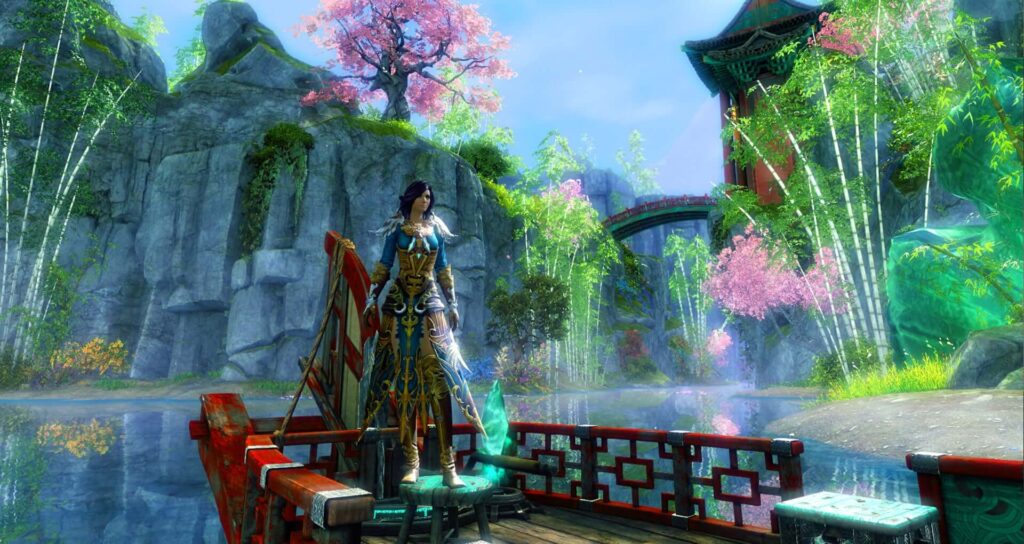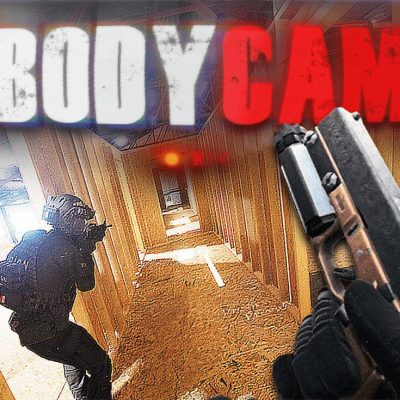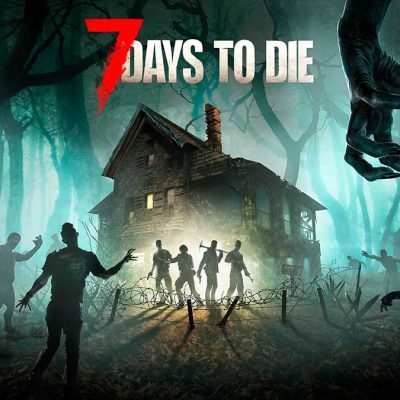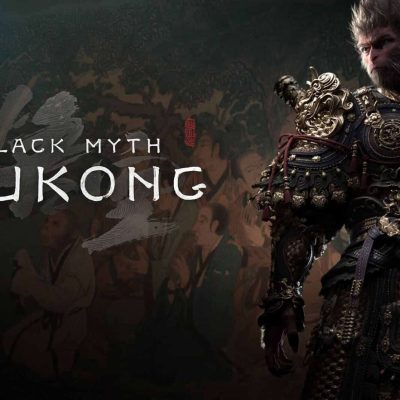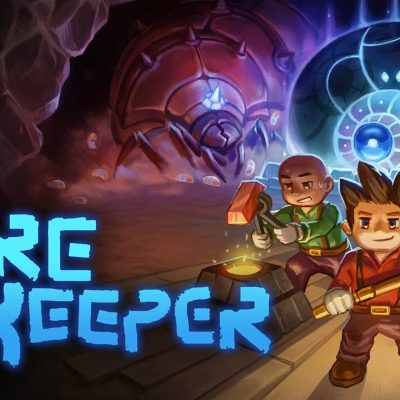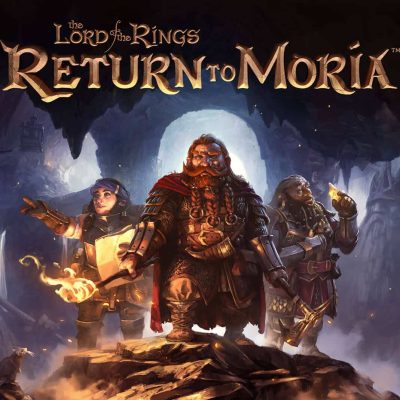When Guild Wars 2 launched in 2012, it revolutionized the MMORPG genre with its unique approach to storytelling, dynamic gameplay, and community-driven events. Over a decade later, Guild Wars 2 has not only withstood the test of time but continues to thrive in 2025. Developed by ArenaNet and operating without a subscription model, the game offers a refreshing alternative to traditional MMOs, attracting new players while keeping its loyal fanbase engaged.
Unlike many games that fade into obscurity, Guild Wars 2 has evolved steadily through expansions, living world updates, and quality-of-life improvements. From Heart of Thorns to End of Dragons, each expansion introduced groundbreaking features like gliding, mounts, and jade technology, shaping the world of Tyria into a vibrant and immersive experience.
Now, in 2025, Guild Wars 2 continues to adapt to modern standards, integrating new technologies, gameplay systems, and challenges that set it apart from competitors. The question remains: is Guild Wars 2 still worth playing in 2025? This review explores its core features, expansions, strengths, and weaknesses, offering a complete perspective for both newcomers and veterans.
Whether you’re looking for intense PvP battles, challenging endgame raids, or a rich, exploration-driven PvE world, Guild Wars 2 provides one of the most complete MMORPG experiences available today. Join us as we dissect its features, evaluate its performance in 2025, and determine where this iconic MMO stands in a constantly evolving gaming landscape.
1. What Makes Guild Wars 2 Unique?
In a gaming world filled with MMORPGs that often feel repetitive, Guild Wars 2 sets itself apart through innovation, player-focused design, and systems that challenge the norms of traditional online games. Even in 2025, these features remain key reasons why players are drawn to the game, providing a unique experience unmatched by its competitors. Here’s what makes Guild Wars 2 truly special:
1.1 The Dynamic Event System
Unlike most MMORPGs that rely on static, repetitive quests, Guild Wars 2 introduces a Dynamic Event System that reshapes the way players interact with the world. Traditional “kill 10 rats” quests are replaced with dynamic, evolving events that occur naturally across the map.
- Events are triggered by player actions or environmental changes, creating a sense of a living, breathing world. For example, a village under attack may call for reinforcements, or a caravan will need protection as it journeys across dangerous terrain.
- The outcomes of these events change the world around you. If you fail to defend a village, it might fall under enemy control, altering NPC behavior and triggering follow-up events.
This system eliminates the monotony of grinding quests and encourages exploration, teamwork, and immersion. Players no longer feel like lone adventurers ticking off tasks; they become part of a reactive world where their actions have consequences.
1.2 The Living World Concept
Introduced post-launch, the Living World concept is one of Guild Wars 2’s defining features. Rather than static updates, ArenaNet releases content that advances the game’s storyline, adds new zones, and evolves the state of Tyria.
- The story unfolds in seasons, with each season comprising episodic updates featuring new maps, events, and lore.
- The world of Tyria evolves permanently. Towns may be rebuilt, new threats may emerge, and landscapes may shift based on the outcome of past events.
This ever-changing world ensures that even returning players have something fresh to experience, keeping the game vibrant over time. The living world doesn’t just add content; it progresses the lore, making players feel like they’re part of an epic, unfolding saga.
1.3 No Holy Trinity – Freedom of Roles
In most MMORPGs, players are locked into rigid roles: Tank, Healer, or DPS. Guild Wars 2 breaks away from this traditional “Holy Trinity” and introduces a flexible combat system where every class (profession) can contribute to multiple roles.
- Every profession has access to self-healing abilities, meaning no one is reliant on a dedicated healer.
- Roles become situational: players can adjust their weapon sets, skills, and elite specializations to fill the needs of a group. For example, a Guardian can focus on supportive healing, tanking, or dealing massive AoE damage depending on their build.
- This system encourages player creativity and reduces dependency on specific group compositions, making content more accessible and group play more flexible.
This design promotes individuality and keeps combat fresh, as players experiment with builds and adapt their playstyle to any situation.
1.4 Horizontal Progression – Skill Over Gear
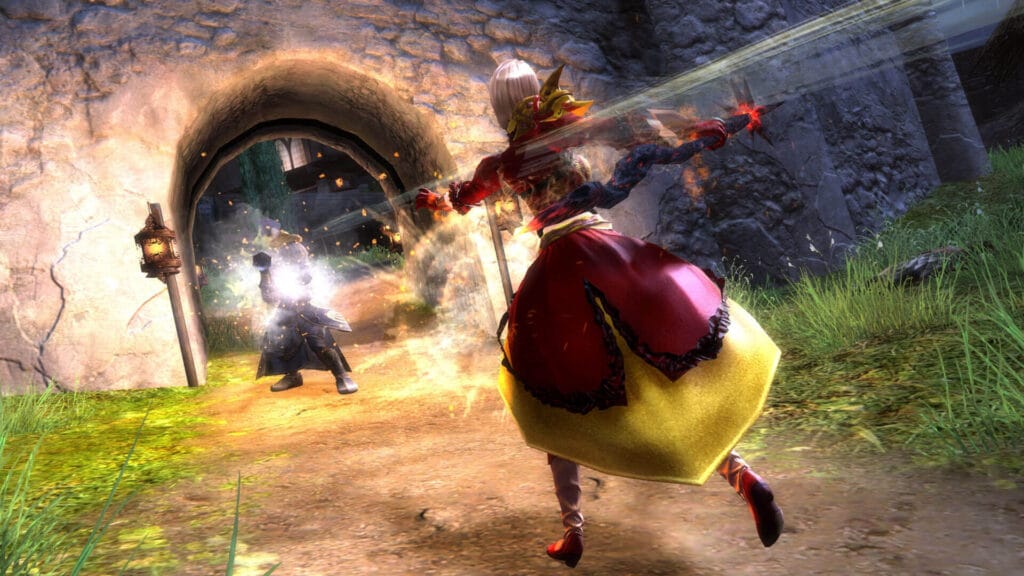
In many MMORPGs, progression revolves around acquiring stronger gear, often leading to an endless treadmill of grinding for power. Guild Wars 2 stands out with its horizontal progression system.
- Gear has a power cap, meaning once you obtain top-tier equipment (Ascended or Legendary), you’re not forced into continuous upgrades.
- Instead of chasing higher numbers, progression focuses on player skill, strategy, and content mastery. Players invest in cosmetics, achievements, and legendary weapons rather than endless gear upgrades.
This system reduces burnout and allows players to focus on enjoying the content rather than grinding for the next set of gear. It also levels the playing field, making the game more welcoming to new players.
1.5 One of the Best Mount Systems in Any MMORPG
When mounts were introduced in the Path of Fire expansion, Guild Wars 2 redefined what mounts could offer in an MMORPG. Instead of simply providing faster movement, mounts were designed as tools for exploration and traversal, each with unique abilities:
- Raptor: Offers long, horizontal leaps, perfect for crossing gaps.
- Springer: Enables vertical jumps to reach high locations.
- Skimmer: Glides across water and hostile terrain.
- Griffon: Allows aerial gliding and speed dives.
- Skyscale: Functions as a flying mount, ideal for vertical exploration.
The Mount Mastery System lets players unlock abilities that further enhance their mounts, such as increased speed or endurance. This innovative approach makes traveling through Tyria both fun and strategic, setting Guild Wars 2 apart from competitors where mounts are merely cosmetic.
1.6 A Truly Player-Friendly Economy
Guild Wars 2 is often praised for its player-friendly monetization. Unlike other MMOs that rely heavily on pay-to-win systems, ArenaNet’s design focuses on fairness and choice:
- No subscription fees: Players buy the base game and expansions, with an option to play the core game for free.
- In-game Trading Post: A robust player-driven economy allows players to trade gold for gems (premium currency), eliminating the need to spend real money for cosmetic items or convenience.
- No Pay-to-Win: Microtransactions are limited to cosmetics, account upgrades, and convenience items that do not affect player power.
This fair approach fosters a healthier player base and makes Guild Wars 2 an attractive option for those seeking an MMO without predatory monetization tactics.
From its dynamic events and ever-evolving Living World to its flexible combat and innovative mount system, Guild Wars 2 breaks the mold of traditional MMORPGs. Its focus on horizontal progression, fair monetization, and immersive storytelling ensures it remains unique, even in 2025. Whether you’re exploring its vast open world, experimenting with elite specializations, or participating in large-scale battles, Guild Wars 2 offers an experience unlike any other in the genre.
2. Core Gameplay Features
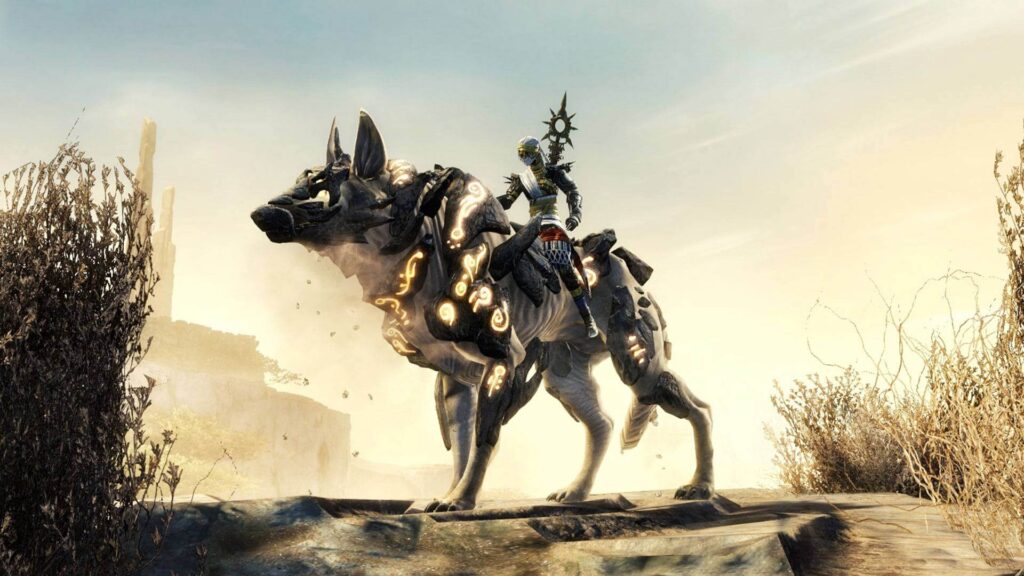
The core gameplay of Guild Wars 2 is where the game truly shines, offering a unique and engaging experience that caters to all types of players. From its fluid combat system to its expansive world, the game delivers both casual enjoyment and deep, challenging content for dedicated adventurers. Here’s an in-depth look at the core gameplay features that continue to make Guild Wars 2 a standout MMORPG in 2025.
2.1 Combat System
Guild Wars 2 features a dynamic, action-oriented combat system that sets it apart from traditional tab-target MMOs. Players are encouraged to move, dodge, and engage actively with their environment, making combat feel both responsive and immersive.
- Weapon Skills: Each profession has unique skills tied to their equipped weapons. For example, a Warrior wielding a greatsword will have powerful cleaving attacks, while an Elementalist with a staff can unleash devastating AoE spells. This system allows players to adapt to different scenarios simply by swapping weapons.
- Active Dodging: Combat incorporates an endurance system that enables dodging, allowing players to evade incoming attacks. Mastering dodging is essential in both PvE and PvP content.
- Combo Fields and Finishers: Guild Wars 2 introduces combo mechanics where skills interact to create powerful effects. For example, placing a fire field and using a projectile finisher will shoot flaming arrows, adding strategic depth to combat.
- No Target Lock: The absence of target locking means players must aim their abilities carefully, enhancing the skill-based nature of the game.
Whether you’re engaging in small skirmishes or massive world events, the combat system keeps players on their toes and rewards precision, movement, and tactical decision-making.
2.2 Exploration and World Design
One of the most praised aspects of Guild Wars 2 is its open-world exploration. ArenaNet designed Tyria as a vast, beautiful, and interactive world that encourages players to venture off the beaten path.
- Map Completion: Every zone includes points of interest, vistas, waypoints, skill challenges, and hearts to complete, providing a sense of achievement for exploring fully.
- Dynamic Events: As mentioned earlier, the world feels alive with events constantly triggering, ensuring that no two visits to the same area feel identical.
- Jumping Puzzles: Scattered across the world are hidden jumping puzzles that test platforming skills, rewarding players with treasure chests, achievements, and sometimes lore.
- World Events: Massive events like world bosses—such as Tequatl the Sunless or the Shatterer—bring players together for epic, cooperative battles that feel larger than life.
- Mount Exploration: With mounts introduced in Path of Fire, exploration became even more engaging. Each mount’s unique abilities allow players to access hidden areas, cross massive gaps, and reach breathtaking heights.
Exploring Tyria is a joy in itself, with each zone offering unique themes, ecosystems, and challenges. From the lush jungles of Heart of Thorns to the desert landscapes of Path of Fire, the world feels meticulously crafted and rewarding to explore.
2.3 Professions and Elite Specializations
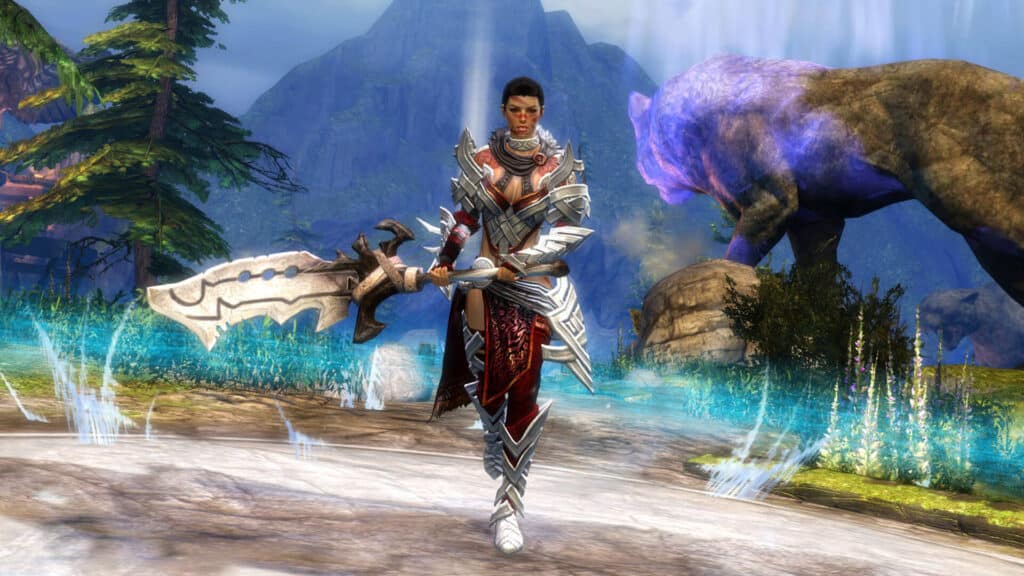
Guild Wars 2 offers nine core professions (classes), each with its own identity and playstyle. Instead of traditional rigid roles, professions are flexible, allowing players to adapt their builds for various situations.
- Core Professions: Ranger, Warrior, Guardian, Thief, Necromancer, Elementalist, Mesmer, Engineer, and Revenant.
- Elite Specializations: Expansions introduced elite specializations that redefine how each profession plays. For example:
- Chronomancer (Mesmer): Manipulate time to reset cooldowns and clone yourself.
- Druid (Ranger): Transform into a healer with powerful support abilities.
- Bladesworn (Warrior): Wield a gunblade for devastating melee attacks.
- Harbinger (Necromancer): Use elixirs to corrupt enemies while enhancing your offensive power.
These specializations provide new ways to play familiar professions, keeping the gameplay fresh and encouraging experimentation. With the ability to swap builds and gear quickly, players can adapt their playstyle to the content they’re tackling.
2.4 PvE Content
Guild Wars 2 provides an extensive variety of PvE content that ranges from casual to hardcore, ensuring there’s something for everyone.
- Dungeons: Dungeons offer story-driven group content with challenging encounters. While less popular in recent years, they remain an excellent introduction to group PvE.
- Fractals of the Mists: These are scalable mini-dungeons that grow in difficulty as you progress through tiers. With mechanics that challenge even veteran players, fractals remain a staple for endgame PvE.
- Raids: Introduced post-launch, raids offer the most challenging PvE content in Guild Wars 2. They require precise coordination, mechanics mastery, and strong builds to succeed.
- Strike Missions: These are faster, more accessible boss encounters that serve as a stepping stone for players new to high-end PvE content.
- Meta Events: Large-scale, map-wide events like Dragon Stand or Drizzlewood Coast require dozens of players to cooperate, offering epic battles and valuable rewards.
The diversity of PvE ensures players can engage in everything from solo exploration to challenging group fights without feeling constrained by gear or roles.
2.5 PvP and World vs World (WvW)
For competitive players, Guild Wars 2 delivers robust and engaging PvP and WvW systems.
- Structured PvP: PvP offers balanced, competitive game modes where all players have equalized gear and stats. Modes include:
- Conquest: A 5v5 mode focusing on capturing objectives.
- Ranked Matches: Seasonal competitive ladders with rewards and leaderboards.
- World vs World (WvW): WvW is a massive-scale, persistent war between three servers. It combines PvE and PvP elements as players:
- Capture keeps, supply camps, and towers to control territory.
- Build and use siege weapons like catapults and trebuchets to break enemy fortifications.
- Engage in massive battles involving hundreds of players at once.
WvW is perfect for those who enjoy large-scale conflicts, while PvP caters to players seeking skill-based, competitive gameplay. The systems remain rewarding and relevant, offering substantial rewards for participation.
2.6 The Mastery System
Introduced with the Heart of Thorns expansion, the Mastery System provides account-wide progression that enhances exploration and gameplay. Instead of leveling beyond 80, players earn mastery points and experience to unlock abilities such as:
- Gliding through the jungle canopy.
- Riding mounts with unique traversal skills.
- Using jade bots in End of Dragons to access hidden areas and interact with tech.
This system ensures that progression remains meaningful while respecting the game’s horizontal design philosophy.
Guild Wars 2 offers one of the most polished and diverse MMORPG experiences available today. From its dynamic, skill-based combat and extensive exploration to its variety of PvE and PvP content, the game continues to deliver engaging and meaningful gameplay in 2025. With flexible professions, elite specializations, and the mastery system, players can always find new ways to enjoy the world of Tyria.
3. Expansions and Major Updates
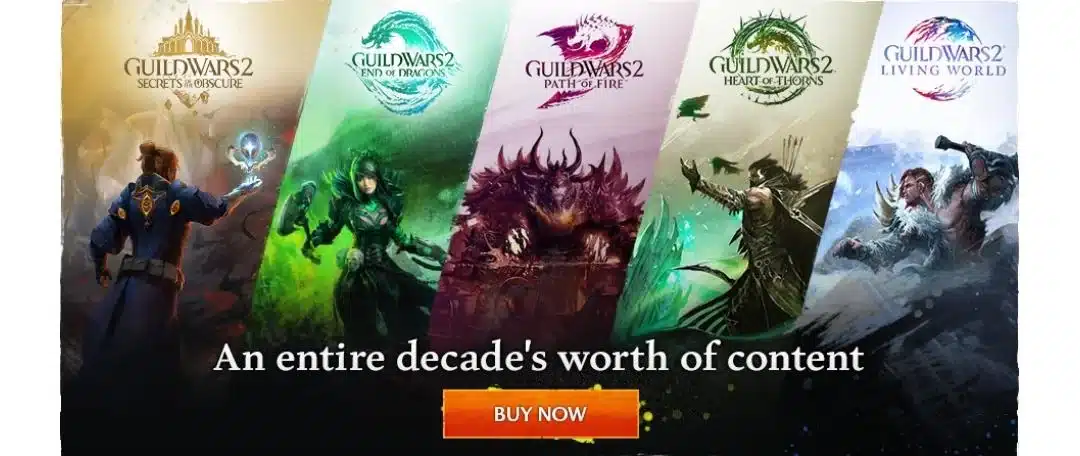
Over its long lifespan, Guild Wars 2 has remained fresh and engaging through its carefully crafted expansions and major updates. Each expansion brought significant changes to gameplay, lore, and the world of Tyria, ensuring players always had new content to explore. From introducing elite specializations and innovative traversal systems to breathtaking maps and evolving storylines, each update has solidified Guild Wars 2’s place as one of the most enduring MMORPGs in 2025.
3.1 Heart of Thorns (2015)
The first expansion, Heart of Thorns, took players deep into the heart of the Maguuma Jungle and introduced systems that would become fundamental to the game’s progression.
- Elite Specializations: Each profession gained its first elite specialization, allowing for more diverse playstyles. For example:
- Chronomancer for Mesmers brought time manipulation and clones.
- Dragonhunter for Guardians introduced traps and a longbow playstyle.
- The Mastery System: This account-wide progression system allowed players to earn experience and unlock new abilities, like:
- Gliding: Explore vertical jungle maps with fluid, rewarding flight mechanics.
- Mushroom Jumping: Use jungle mushrooms to leap across massive gaps.
- Challenging PvE Content: Heart of Thorns introduced Raids, catering to players looking for high-end, organized PvE content. The Meta Events in jungle zones, such as Dragon’s Stand, brought large-scale, cooperative challenges to life.
- Verdant Maps: Stunning and intricate maps like Auric Basin, Tangled Depths, and Dragon’s Stand highlighted the expansion’s verticality, introducing multi-layered zones that demanded exploration.
Heart of Thorns redefined exploration and set the groundwork for future updates by blending vertical movement with story-driven gameplay.
3.2 Path of Fire (2017)
Path of Fire is often celebrated as one of the most successful expansions in Guild Wars 2, largely due to its mount system and the stunning deserts of Elona.
- Mounts Revolutionized Exploration: Instead of simply offering speed boosts, mounts became tools for traversal, each with unique skills:
- Raptor: Long-distance horizontal leaps.
- Springer: High vertical jumps.
- Skimmer: Glide over water and hazardous terrain.
- Jackal: Teleport short distances using sand portals.
- Griffon: A secret mount enabling aerial gliding and dives.
- Elite Specializations: Each profession gained a second specialization, such as:
- Soulbeast (Ranger): Merge with pets for powerful bonuses.
- Firebrand (Guardian): Wield tomes for supportive and offensive fire magic.
- Deadeye (Thief): Focus on long-range sniper play with a rifle.
- Expansive Maps: Vast, beautiful deserts like the Crystal Oasis, Elon Riverlands, and Desolation delivered both beauty and danger, with open-world exploration rewarding players with dynamic events and treasure.
- The Return of Balthazar: The expansion’s narrative focused on Balthazar, the rogue God of War, leading to epic confrontations and emotional story beats.
Path of Fire not only expanded the world but also redefined player movement, with mounts quickly becoming a staple of Tyria.
3.3 End of Dragons (2022)
Set in the long-awaited land of Cantha, End of Dragons delivered a mix of technological wonder, new mechanics, and deep lore tied to the legacy of Guild Wars 1.
- New Elite Specializations: Professions gained their third elite specializations, offering even greater diversity in playstyle:
- Bladesworn (Warrior): Wield a gunblade for devastating hybrid attacks.
- Harbinger (Necromancer): A risk-reward playstyle using elixirs to empower damage.
- Mechanist (Engineer): Summon and customize a mech companion to fight alongside you.
- Jade Tech and Skiffs:
- Jade Bots: Small robotic companions that aid in traversal, revive players, and interact with Cantha’s technology.
- Skiffs: Multiplayer boats for fishing and navigating Cantha’s waterways.
- Fishing: A relaxing addition allowing players to catch fish across Tyria, complete collections, and earn rewards.
- Stunning Maps: Cantha’s maps—like Seitung Province, New Kaineng City, and Echovald Wilds—combined ancient aesthetics with futuristic jade technology, creating a unique and immersive setting.
- Strikes and Meta Events: End of Dragons refined strike missions, offering challenging but accessible boss fights for players, while large-scale meta events like the Battle for the Jade Sea delivered unforgettable cooperative experiences.
End of Dragons balanced nostalgia with innovation, giving players a vibrant and technologically advanced setting to explore.
3.4 Secrets of the Obscure (2023)
The Secrets of the Obscure expansion shifted focus toward Tyria’s skies and introduced mysterious new story elements, enhancing both gameplay and lore.
- The Wizard’s Tower: The story centered on the ancient wizard’s tower and introduced aerial adventures that tied deeply into the magical history of Tyria.
- New Combat Options: Professions gained access to expanded weapon proficiencies, allowing new builds and playstyles.
- The Skyscale Mastery: The flying Skyscale mount became central to traversal, with expanded abilities enabling players to fly further and faster.
- Rift Hunting: A new activity where players seal Rifts across Tyria, offering replayable content and rewards.
This expansion catered to veteran players while maintaining accessibility for newer audiences.
3.5 Living World Seasons
Between expansions, Guild Wars 2 continued its story through the Living World seasons. Each season offered episodic content updates that included:
- New storylines advancing the central conflict of Tyria.
- New zones, events, and gameplay mechanics.
- Major events, like the defeat of the Elder Dragons and the rise of new threats.
Seasons like The Icebrood Saga and Living World Season 4 introduced breathtaking zones, such as Dragonfall and Bjora Marches, along with exciting new mechanics and boss battles.
3.6 Quality-of-Life Updates and Future Proofing
Over the years, Guild Wars 2 has been enhanced through quality-of-life improvements:
- DirectX 11 Support: Improved graphics and performance to match modern standards.
- Improved UI and Systems: Updates to crafting, trading, and build templates make the game more user-friendly.
- Cross-Region Play: Reduced barriers for playing with friends globally.
- Regular Balance Updates: Professions and specializations are frequently balanced to ensure diverse and fair gameplay.
These ongoing updates demonstrate ArenaNet’s commitment to keeping Guild Wars 2 relevant and competitive in the modern MMORPG market.
Each expansion and major update has propelled Guild Wars 2 forward, introducing innovative mechanics, rich storytelling, and beautiful environments. From gliding in Heart of Thorns to the dynamic mounts of Path of Fire and the technological wonders of End of Dragons, every addition has expanded the game’s scope and appeal. Combined with living world seasons and consistent quality-of-life updates, Guild Wars 2 remains a shining example of how an MMORPG can evolve and endure.
In 2025, the game continues to grow, offering a vast world filled with challenges, exploration, and stories for both new and returning players.
5. Pros and Cons of Guild Wars 2
Pros:
- Engaging, action-based combat.
- No subscription fee.
- Extensive free-to-play content.
- Unique progression system with no gear treadmill.
- Dynamic and evolving world events.
- One of the best mounts systems in any MMORPG.
Cons:
- Raids and endgame PvE lack accessibility for casual players.
- PvP balance can feel inconsistent.
- Long gaps between major content releases.
6. Is Guild Wars 2 Worth Playing in 2025?
In 2025, Guild Wars 2 stands as a testament to ArenaNet’s innovation, commitment, and vision for a player-focused MMORPG. Its dynamic combat, stunning world design, flexible progression, and diverse content make it a standout title in a crowded market. Whether you’re a solo adventurer, a team-based PvE raider, or a competitive PvP player, Guild Wars 2 offers something for everyone.
With no subscription fee, constant updates, and one of the most welcoming communities in gaming, Guild Wars 2 remains one of the most accessible and rewarding MMORPGs for both new players and veterans. If you’re looking for a game that values player choice, exploration, and innovation, Guild Wars 2 is absolutely worth playing in 2025.

